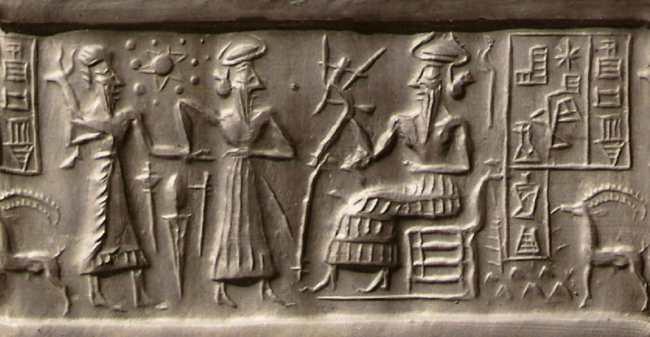VA243 Cylinder Seal
By Joseph Pease

The VA 243 Cylinder Seal is an artifact of Sumerian origin, and in the realm of pseudoarchaeology, purported to be real evidence of contact between that ancient civilization and extraterrestrial beings. In his book, The 12th Planet Zecharia Stitchin uses theorizes that the Sumerians had advanced knowledge of the stars, planets, and other heavenly spheres due to the involvement of the alien beings from the twelfth planet beyond Neptune, Nibiru[2]. This book uses the cylinder seal as a evidential centerpiece, with its inscriptions being a "secret code" that points to the Sumerian cosmological knowledge, hidden in plain sight.
Context
Annunaki and "Planet" Nibiru
The Annunaki were divine entities within the myths and religions of ancient Mesopotamia. These deities can be found among the various cultural myths of the region, from the Babylonians to the Akkadians and Assyrians[3]. These deities are shrouded in mystery, as little evidence of their worship remains. From what can be ascertained from surviving representations and records, these gods had various roles and varying aspects in the different regions of the ancient Middle East. Within the Sumerian mythos, these gods are descended from the sky, but their specific roles aren't exactly known. They are, however, associated with the heavenly bodies in Sumerian cosmology. Inana (Venus), Utu (Sun), and Nanna (Moon) are principal among them, with others representing various other stellar spaces[4]. This vagueness of substance and evidence has made the ethereal Annunaki a common sight in pseudoarchaeological theories, being seen as alien beings who came to the earth to guide, enslave, or create human beings and civilizations. Their representative connections to the planets of our solar system also lends credence to these theories by giving them a mythological and allegorical framework for amateur theorists to work with.
Sumerians and Cylinder Seals
Artifact History
Psuedoarchaeological Narrative
Deconstructing the Narrative
References
- ↑ Museum artifact published by Anton Moortgat, "West Asian Cylinder Seals," Vorderasiatische Rollsiegel (1940)
- ↑ Sitchin, Zecharia 2016 The 12th planet. Ishi Press International, Bronx, NY
- ↑ Black, Jeremy; Green, Anthony (1992), Gods, Demons and Symbols of Ancient Mesopotamia: An Illustrated Dictionary, London, England: The British Museum Press, Pg.34
- ↑ Black, Jeremy; Green, Anthony (1992), Gods, Demons and Symbols of Ancient Mesopotamia: An Illustrated Dictionary, London, England: The British Museum Press, Pg.108-109, 182, 135